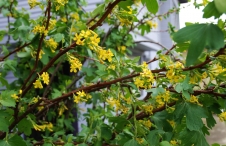Utah Juniper
Utah juniper (Juniperus osteosperma) occurs in every county of the state, and it covers more acreage in Nevada than any other tree. It is extremely adaptable, occurring in low valleys as well as in high-elevation mountain shrub communities, ranging in elevation from 2000 to 8000 feet. Utah juniper is distributed over at least 200 mountain ranges and is absent only in the northernmost mountain ranges of the state.
Utah juniper is most commonly found as an associate of singleleaf pinyon, Pinus monophylla, and is a key component of Nevada's pinyon-juniper woodlands. The more drought-tolerant juniper dominates at lower elevations and becomes scarce at moderate elevations, where pinyon dominates; it then reappears on dry, rocky ridgetops. Utah juniper is usually the first of the two species to establish following fire or other disturbances and creates the environmental conditions in which pinyon can subsequently establish.
The growth form of Utah juniper is highly variable. It can occur as a tree with a single straight trunk or more commonly as a multi-stemmed, arborescent shrub. Utah junipers seldom reach over thirty feet in height, although they can have tremendous girth, exceeding four feet in diameter. The shaggy, fibrous bark of the Utah juniper is distinctive, and its cedar-like sprays, light green in color, are arranged in stiff clumps.
Utah juniper produces berry-like cones that may contain one or more seeds. These "berries" are important fall and winter food for numerous wildlife species. Although the foliage is of low palatability and has high volatile oil content, it is an important winter browse for mule deer in Nevada.
Native peoples of the Great Basin made extensive use of Utah juniper. The wood was used for construction materials, carved utensils, and fuel for cooking, while the fibrous bark was woven into sandals, clothing, and rope. Nineteenth century Euro-American settlers similarly valued the rot-resistant wood for construction materials and fence posts. Today juniper is cut for firewood, and juniper fence posts are still commonly seen on remote ranches. Perhaps most importantly, juniper trees provide shade for humans, wildlife, and livestock on some of the hottest sites of the pinyon-juniper woodland.



